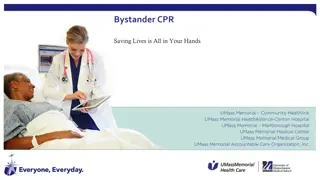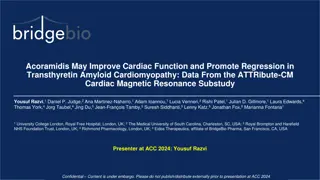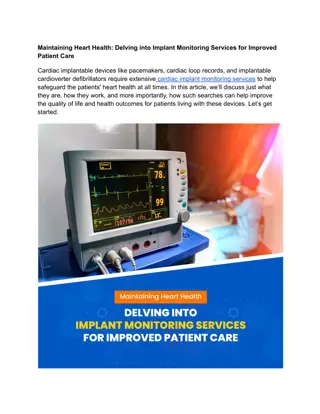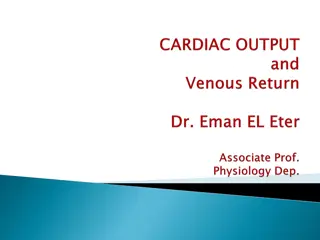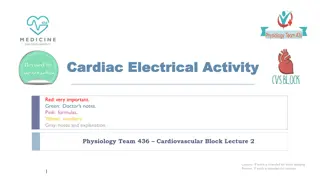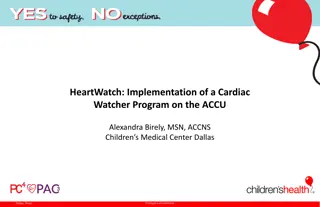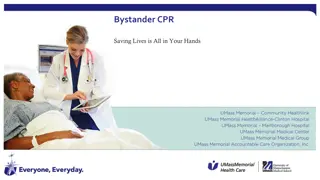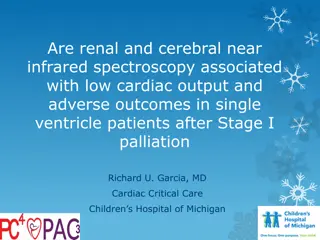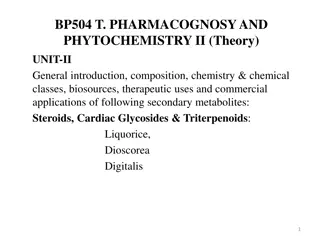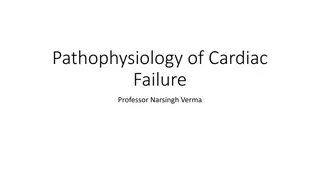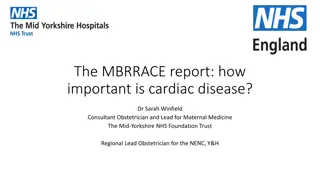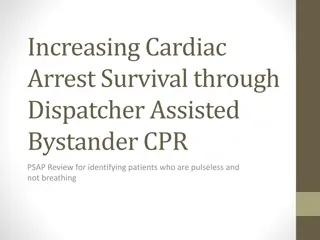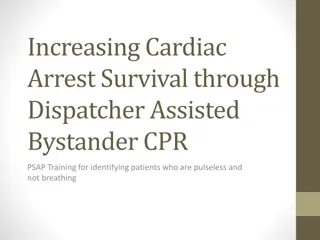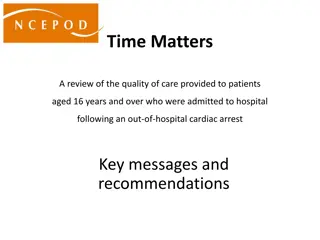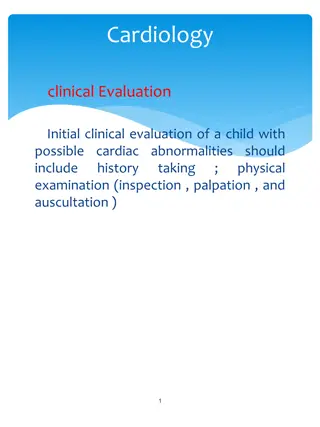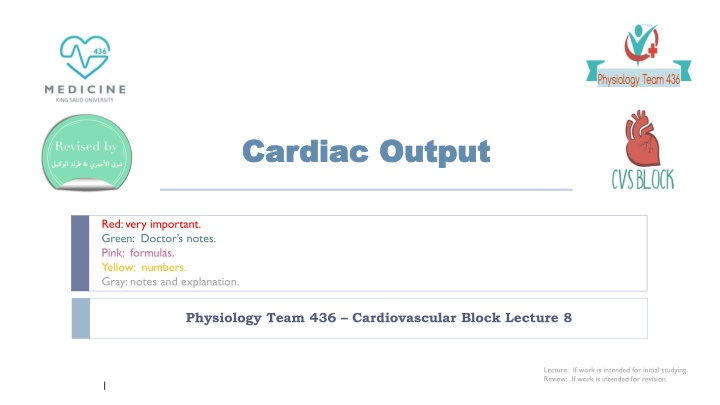
Cardiac Output
Dive into the intricate details of cardiac output regulation and venous return in cardiovascular physiology. Learn about the factors influencing cardiac pump function and the dynamics of blood flow through the heart. Explore the essential concepts necessary for a comprehensive understanding of cardiovascular health and function.
Download Presentation

Please find below an Image/Link to download the presentation.
The content on the website is provided AS IS for your information and personal use only. It may not be sold, licensed, or shared on other websites without obtaining consent from the author. If you encounter any issues during the download, it is possible that the publisher has removed the file from their server.
You are allowed to download the files provided on this website for personal or commercial use, subject to the condition that they are used lawfully. All files are the property of their respective owners.
The content on the website is provided AS IS for your information and personal use only. It may not be sold, licensed, or shared on other websites without obtaining consent from the author.
E N D
Presentation Transcript
Cardiac Cardiac Output Output Red: very important. Green: Doctor s notes. Pink: formulas. Yellow: numbers. Gray: notes and explanation. Physiology Team 436 Cardiovascular Block Lecture 8 Lecture: If work is intended for initial studying. Review: If work is intended for revision. 1
Objectives Study Smart: focus on mutual topics. From the students guide: By the end of this lecture the students are expected to: Define cardiac output, stroke volume, end-diastolic and end-systolic volumes. Define physiological conditions affecting CO List causes of high and low output pathological states. Define venous return and describe factors controlling venous return. 2
The Cardiac Output (C.O) C.O regulation: is well regulated according to tissue metabolic demands. Video of (Cardiac Physiology of CO) Duration: (8:48 mins) Video of (Cardiac Output) Duration: (9;39mins) Basic determinant of C.O.: is the O2 requirements of body tissues, for their metabolic rates. C.O.: isthe volume of blood flow ejected from the right or left ventricle per minute. = 5 L\min at rest. Stroke volume: is the volume of blood ejected from each ventricle per beat. = 70 ml\beat at rest Heart Rate = 72 beats\ min. Accordingly, if the metabolic rate is increased the CO and VR are increased WHY? to maintain optimal O2 supply to the active tissues. Thus, the cardiac output = the volume of blood pumped by one ventricle per beat X the number of beats per minute: Resting C.O Per minutes NOT beat ONLY IN FEMALES SLIDES C.O (Q) = Heart rate X stroke volume Men 5.6 L/min Average adult 5 L/min Women 4.9 L/min Cardiac output: volume of blood out of heart per minute Stroke volume: volume of blood out of heart per beat 3
ONLY IN MALES SLIDES Cardiac Reserve: VR and CO Venous return (VR): refers to the volume of blood entering each atrium per minute. The cardiac output at rest is approximately 5 L/min. VR = Heart rate X Diastolic filling volume = 5 L/min The body s blood volume averages 5 to 5.5 liters. Venous return: flow rate into the heart Cardiac output: flow rate out of the heart (heart rate) Thus, each ventricle pumps the equivalent of the entire blood volume each minute. During exercise, the CO can increase to 20 - 25 liters/min and to as high as 35 - 40 liters/min in well trained athletes. Coupling of cardiac and vascular functions The difference between the resting CO and the maximum volume of blood: the heart is capable of pumping per minute is known as the cardiac reserve. The ventricles function: as the central pumps in the closed circuit of the CVS. Thus, the cardiac output should be equal to the rate of venous blood return to each ventricle. 4
ONLY IN MALES SLIDES Regulation of the Cardiac Pump The hemodynamic function of the human heart has two components: To be filled by the venous return (VR) To produce an outflow (i.e., cardiac output) with pressure. 1. 2. 2 groups of factors that regulate the haemodynamic functions of the heart: Factors affecting the pump ability to eject (i.e., CO) Factors affecting the pump filling (i.e., VR) 1. 2. These factors include: Intrinsic properties of the heart and blood vessels which provide an autoregulation to the heart pump. ( ) Neuro-hormonal factors outside the CVS which constitute an extrinsic regulation. 1. 1. 5
Factors affecting & regulating cardiac output Video of (Regulation of CO) Duration: (14:33 mins) Heart rate Stroke volume Increase HR Decrease HR Bainbridge reflex = Atrial reflex Decrease blood volume Frequency- force relationship Sympathetic Nervous system* Increase temperature Hormones Exercise** pregnancy muscle need more O2 heart need to pump more blood. crisis (e.g. Stress , anxiety , fear .. etc.). Epinephrin (neurotransmit ter) E.g. In the right atrium there is Stretch receptor, which response to venous return ( increase in pressure ) by increasing the heart rate through sympathetic activity. Increase cardiac contractility i.e. hyperthyroidism Thyroxine (thyroid hormone which increases HR) High BP Trauma i.e. hemorrhage *Increase contractility (strength of contraction) and BP and SV (volume of blood) and therefore increase CO **Increases HR then increases CO because muscles need more O2 supply and that is done by increasing HR to pump more blood to the muscles to supply them and remove lactic acid 6
ONLY IN MALES SLIDES Physiological/Pathological Changes In Cardiac Output Physiological changes Pathological changes During the first 3 hours after meal: the CO is increased by 30% to enhance blood flow in the intestinal circulation. Causes of low CO: Low VR (e.g., haemorrhage) Reduced contractility (e.g., heart failure) Tachyarrhythmias (e.g., atrial fibrillation and ventricular tachycardia) Marked bradycardia (e.g., complete heart block) Later months of pregnancy: are accompanied by > 30% increase in CO due to increased uterine blood flow. At environmental temperature above 30 C : the CO is increased due to increased skin blood flow. Causes of high CO: Hyperthyroidism: the increase in the CO is due to the high metabolic rate vasodilatation CO to 50%+ of control. AV fistulas Fever Anaemia Anxiety At low environmental temperature: CO is increased due to shivering that increases blood flow to the muscles. Increased sympathetic activity: during anxiety and excitement enhances the CO up to 50% - 100%. Sitting or standing from the lying position: deceases the CO by 20% - 30%. Exercise: (next slide) 7 Hyperthyroidsm more metabolism more oxygen
Physiological Changes In Cardiac Output Moderate Exercise In severe exercise: CO is increased by 5-7 times (due to increase in HR & SV) HR increases to SV increases to CO increases to 200% of resting (140 bts/min) 120% (85ml) 240% (12L) Severe Exercise Athletes at rest: HR less CO is the same SV more HR increases to SV increases to CO increases to 300% of resting (200 bts/min) 175% (125ml) 500% - 700% (25 - 35 L) In athletes: maximum CO may be 35L or more - can't increase maximum HR beyond 200 bts - hence - SV increases to 175 ml. 8
Factors affecting & regulating cardiac output Stroke volume Heart rate Increase HR Decrease HR Myocardial contractility Preload Afterload End systolic/ diastolic volume High blood pressure or blood volume ventricular myocardiam Parasympathetic nervous system by negative effect The Bainbridge reflex, is an increase in heart rate due to an increase in central venous pressure. Increased blood volume is detected by stretch receptors (baroreceptors) located in both atria at the venoatrial junctions. The stretch receptors are sensitive to venous return. volume of blood entering the right atrium will cause stretching in the receptors. when the receptors are stretched, they will send signals to the brain which will increase the heart rate. 9
ONLY IN FEMALES SLIDES Summary 11 Read do not skip!
ONLY IN MALES SLIDES Factors Affecting Cardiac Output Nerve Supply to the Heart Sympathetic nerves Innervate the whole heart. Release noradrenaline stimulates heart 1-receptors increase HR Heart Rate Since the CO is = SV x HR, as the heart rate increases CO increases (logically). (adrenaline), which At heart rates up to about 180 Beats/min ventricular filling is adequate as long as there is enough venous return, and cardiac output per minute is increased by an increase in heart rate. Parasympathetic nerves Innervate the SA and AV nodes, and the atria and Purkinje system. Do not innervate most of the ventricular myocardium. Release ACh that stimulates muscarinic (M2) receptors reduce HR Slows the heart but has little inotropic action. However, at very high heart rates, filling may be compromised to such a degree that cardiac output per minute falls. 12 CO=Cardiac Output SV=Stroke Volume Atrium = Ventricle =
ONLY IN MALES SLIDES 1- Mechanisms of Neural Control Mechanisms: The 1-adrenoreceptors on SA node cells are coupled to excitatory G- proteins This activates the enzyme adenylate cycles increases cAMP as a second messenger inside the cell This results in: Mechanisms: M2 (muscarinic-2) ACh receptors respond to ACh from the vagus nerve by activating a different G-protein. This results in: Reduces the levels of cAMP in the cell Closure of Na+ and Ca2+ channels Opening of potassium channels in the cell membrane Hyperpolarizes the cell and makes it more difficult to initiate an action potential. Opening of Na+ and Ca2+ channels speed up the rate of depolarization and hence the heart rate. Decrease in K+ permeability by accelerating inactivation of the K+ channels. Thus, fewer positive potassium ions leave the cell the inside of the cell becomes less negative depolarizing effect. The net effect is: slower drift to threshold lesser frequency of action potential decrease the heart rate. The net effect is: swifter drift to threshold greater frequency of action potential increase the heart rate. 13
ONLY IN MALES SLIDES 2- Frequency Force Relationship The force of contraction of the cardiac muscle is increased when it is more frequently stimulated. This frequency dependency of force generation in the heart is probably due to accumulation of Ca2+ ions within the myocytes as a result of: The increased in number of depolarizations/min more frequent plateau phases more Ca2+ entry. The magnitude of Ca2+ current is also increased increases the intracellular Ca2+ stores. Both effects enhance the release and uptake of Ca2+ by the sarcoplasmic reticulum, thus Ca2+ availability to the contractile proteins with more force generation through cross-bridge cycling. So, Increase HR due to increase Contractility : 1 - 2 - 14
Cardiac Index and Cardiac Output Cardiac index: is a ratio or relation Cardiac Index Cardiac Output Measurement The Direct Fick s Method: The amount or volume of any substance taken up by an organ or by the whole body is equal to: (The arterial level of the substance the venous level) X blood flow. Amount Blood flow = (Arterial level Venous level) It relates the cardiac output to body surface area. Thus relating heart performance to the size of the individual. (Measuring the concentration of any substance in the arteries and veins) The unit of measurement is liter per minute per square meter of body surface area (L/min/m2). Cardiac index for the human being at different ages: ONLY IN FEMALES SLIDES 15
ONLY IN FEMALES SLIDES Methods for Measuring Cardiac Output Girls Doctor said that the scientist and the equation are important but the rest is not so just read it. Cardiac output can be measured using the Fick principle: - In the steady state, the cardiac output of the left and right ventricles is equal. - In the steady state, the rate of O2 consumption by the body must equal the amount of O2 leaving the lungs in the pulmonary vein minus the amount of O2 returning to the lungs in the pulmonary artery. Total O2 consumption or the rate of O2 absorption by the lungs can be measured by the rate of disappearance of oxygen from respired air, using any oxygen meter. The amount of O2 in the pulmonary veins is pulmonary blood flow multiplied by the O2 content of pulmonary venous blood. Likewise, the amount of O2 returned to the lungs via the pulmonary artery is pulmonary blood flow multiplied by the O2 content of pulmonary arterial blood. O2 consumption = cardiac output [O2] pulmonary vein cardiac output [O2] pulmonary artery Cardiac output = O2 absorbed by the lungs per minute/arteriovenous O2 difference 16
ONLY IN MALES SLIDES Measurement of Cardiac Output 2-Dimensional echocardiography Fick s principle Ultra-fast computer tomography Records real-time changes in ventricular dimensions during systole and diastole. It thus computes : stroke volume, which when multiplied by heart rate, gives the = cardiac output Fick s principle assumes that the amount of oxygen consumed by an organ = the amount of oxygen delivered to that organ by the arterial blood minus the amount of oxygen left in the venous blood of the organ. O2 consumed = O2 delivered-O2 in venous Can measure changes in ventricular diameter at several depths to estimate changes in ventricular volume. Amount of oxygen delivered by the arterial blood = aO2 . Blood flow through the organ (Q). Amount of oxygen left in the venous blood = vO2 . Q. The amount of oxygen consumed by the organ = (aO2 . Q) - (vO2 . Q) = Q (aO2 - vO2). Thus Q =The amount of oxygen consumed aO2 - vO2 17
ONLY IN FEMALES SLIDES The Heart has Limits for Achievable Cardiac Output (Girl s doctor said just read it) Factors that can cause hypereffective heart: Nervous stimulation Hypertrophy of the heart muscle 1. 2. Sympathetic inhibition can increase the effectiveness of the heart via: Increasing the heart rate Increasing the strength of heart contraction stimulation and parasympathetic 1. 2. Increased pumping effectiveness caused by heart hypertrophy 50-75% increase in the heart mass of marathon runners which increases the plateau of cardiac output 60-100%. This figure shows the normal cardiac output curve at each level of right atrial pressure.The plateau level of this normal cardiac output is 13 L/min. This means that the heart can pump an amount of venous return up to 2.5 times the normal venous return before the heart becomes a limiting factor in the control of cardiac output. 18
Quiz https://www.onlineexambuilder.com/stroke-volume/exam-140345 Link to Editing File (Please be sure to check this file frequently for any edits or updates on all of our lectures.) References: Girls and boys slides. Guyton and Hall Textbook of Medical Physiology (Thirteenth Edition.) 19
Thank you! . The Physiology 436 Team: Team Leaders: Qaiss Almuhaideb Lulwah Alshiha Female Members: Rana Barasain Ashwaq Almajed Amal AlQarni Jawaher Abanumy Reema Alotaibi Leena Alwakeel Hayfaa Alshaalan Male Members: Abdullah Abu-amarah Abdulmajeed AL-Amar Ali Alsubaie Muhammad Almutlaq Contact us: Physiology436@gmail.com @Physiology436 20

